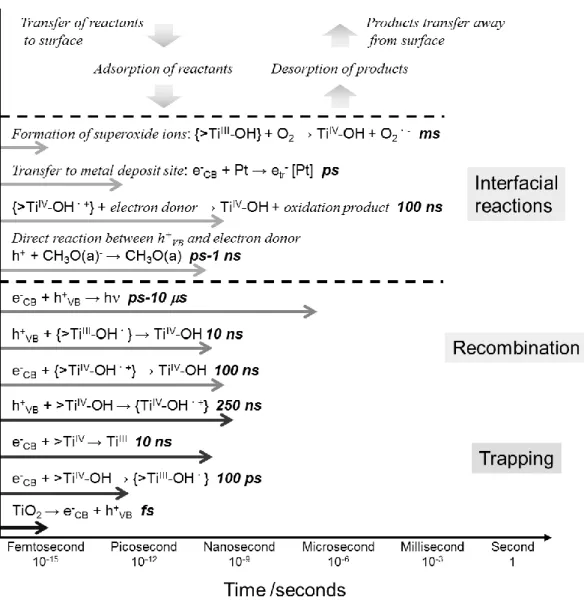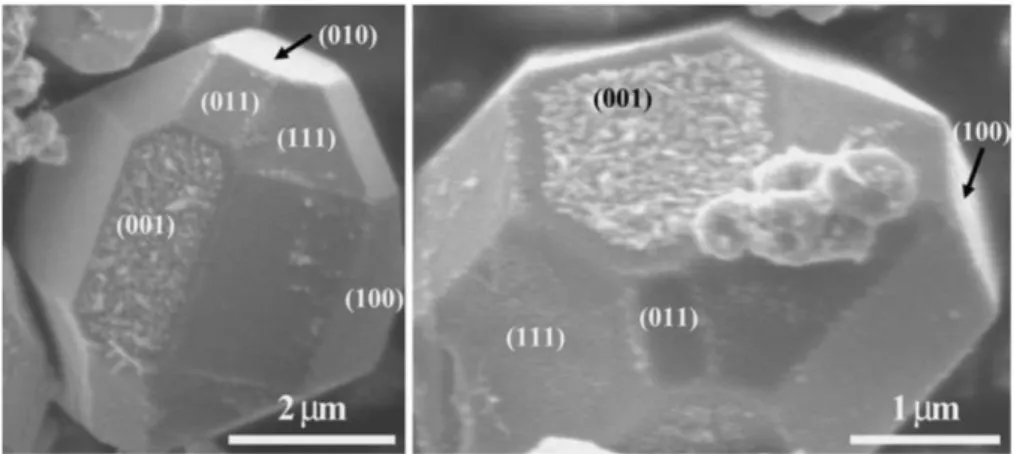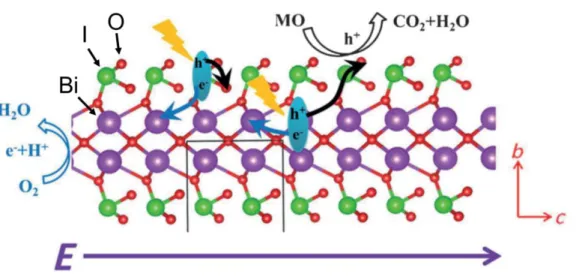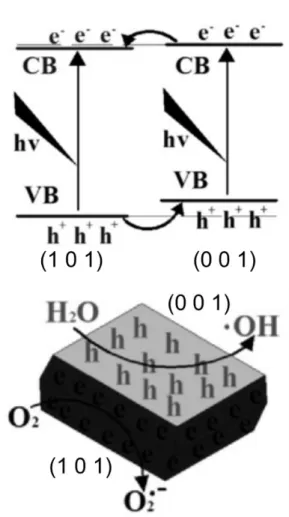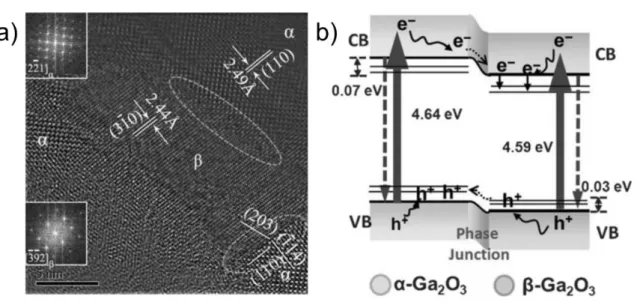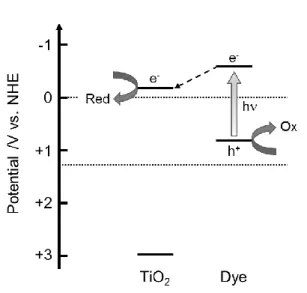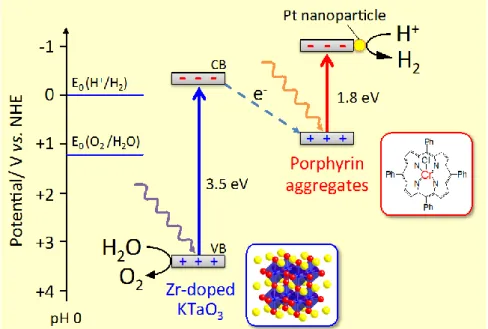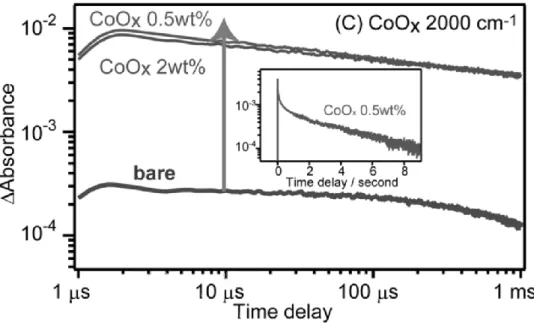総 説
不均一系光触媒反応における光生成電荷の分離機構
萩原 英久
富山大学 研究推進機構 水素同位体科学研究センター
〒930-8555 富山市五福3190
Separation Mechanism for Photogenerated Charge Carriers in Heterogeneous Photocatalysts
Hidehisa Hagiwara
Hydrogen Isotope Research Center, Organization for Promotion of Research, University of Toyama, Gofuku 3190, Toyama, 930-8555, Japan
(Received June 30, 2017; accepted July 31, 2017)
Abstract
In heterogeneous photocatalysts, it is very important to move photoexcited charges in the semiconductor to the reaction site on the surface without recombination. In this review, we describe the process of the photocatalytic reaction from photoexcitation of semiconductor photocatalyst to surface redox reaction, and summarized various researches on the charge separation of photogenerated electrons and holes in semiconductors reported up to the present.
1. Introduction
Heterogeneous photocatalysts have been widely used for various applications such as antibacterial coating,1,2 deodorizing,3 antifogging treatment,4,5 and water purification,6,7 and become more important in the future. Furthermore, a photocatalytic solar energy conversion,
so-called artificial photosynthesis, has actively studied to solve global energy problems.8,9 To improve the activity and the functionality of photocatalysts, it is necessary to understand a series of photocatalytic processes in detail. Figure 1 shows elementary reactions of TiO2 photocatalyst with corresponding timescales. Under light irradiation with a higher energy than the bandgap energy of the semiconductor photocatalyst, electrons in the valence band (VB) make transition to the conduction band (CB) with leaving holes in the valence band. While the photogenerated electrons transfer to the bottom of the CB, the holes transfer to the top of the VB, via vibrational relaxation process. These charge generation and relaxation processes occur in the order of
Fig. 1 Elementary reactions in TiO2 photocatalysis with corresponding timescales.
femtoseconds. The photogenerated electrons and holes diffuse in the CB and the VB, respectively, and part of them are trapped at the energy level formed by atomic vacancy, impurity, or functional groups on the photocatalyst surface. In the charge recombination process, the photogenerated charge carriers annihilate each other releasing the energy as a photon or phonons. These trapping and recombination processes take place in the order of nanoseconds or microseconds. On the other hand, the photogenerated electrons and holes without recombination react with adsorbed chemical species, or transfer to metal or metal oxides on the photocatalyst surface. The redox reactions on the photocatalyst surface occur in the order of the microseconds or milliseconds, thus it is considered that the photocatalytic activity is improved by suppressing the charge recombination at trap site or photocatalyst surface. Therefore, this review covered up the several approaches of the photogenerated carrier separation in heterogeneous photocatalysts, for development of the highly active photocatalysts.
2. Charge separation in semiconductor photocatalysts
Photogenerated electrons and holes in optical semiconductors diffuse in conduction and valence bands along electric fields. In silicon type solar cells, the charge separation takes place at the interface between p-type semiconductors (e.g. boron-doped silicon) and n-type
Fig. 2 Energy band diagrams of (a) p-n junction and (b) semiconductor-electrolyte interface.
semiconductors (e.g. phosphorus-doped silicon), so-called p-n junction, because of a potential gradient in a space charge region (Fig. 2a). The formation of space charge region in semiconductor photoelectrodes of photoelectrochemical cells are explained by a band-bending model, which is based on an interdiffusion of electrons and holes between semiconductors and redox species in electrolyte (Fig. 2b). In the case of semiconductor photocatalyst powders, the space charge region forms in a similar manner to that of the photoelectrodes. The length of the space charge region depends on the carrier density of the semiconductor photocatalysts, and it is estimated within 20-100 nm.4,10 Therefore, the reduced effect of the band bending is one of the reasons for increasing charge recombination in photocatalyst particles with size within 100 nm. Although the space charge properties are determined by surface/interface electronic states, the photogenerated charges can also be controlled by electric fields induced dielectric structures or difference in the surface electronic band structures of crystal facets, as described below.
2.1. Ferroelectric materials
Barium titanate (BaTiO3), which is one of the most popular ferroelectric materials, has been investigated to reveal the charge separation effect of internal electric fields.11-17 BaTiO3 shows the spontaneous polarization between 278 K and 393 K, because Ti and Ba atoms shifted to
<100> direction and O atoms shifted negatively from cubic perovskite structure, as shown in Fig.3.18 To confirm the effect of the spontaneous polarization on the charge separation and the photocatalytic reactivity, Ag+, Pb2+, and Mn2+ ions were employed as reaction marker.
These ions were deposited on the photocatalyst surface as Ag, PbO2, and MnO2 by photocatalytic reduction or
oxidation reactions, and the migration behavior of Fig. 3 Crystal structure of BaTiO3.
photogenerated carriers in semiconductor crystals was determined by surface observation.
Figure 4 shows SEM images of BaTiO3 crystals prepared after the photoirradiation in AgNO3
aqueous solution.17 In this study, BaTiO3 crystals were prepared by KCl flux method, and the deposition of Ag particles was observed on (001) plane of BaTiO3 crystals. This result suggests that Ag is reduced by photogenerated electrons migrated along the direction of ferroelectric polarization. In addition to the research on BaTiO3, various ferroelectric materials, such as Pb(Zr, Ti)O3,19-26 BiFeO3,27 LiNbO3,28 and Sr2Nb2O7,17 have been reported as active photocatalysts for water splitting, hydrogen production, and water purification.
The photocatalytic properties of pyroelectric materials have been also studied for understanding the efficient charge separation. Huang et al. reported that bismuth-based compounds, BiOIO3,29 Bi2O2[BO2(OH)],30 and Bi4V2O1131 showed high photocatalytic activity for organic compound oxidation or oxygen formation from AgNO3 aqueous solution. As shown in Fig. 5, BiOIO3 is composed of central Bi2O4 layer shares O corners with IO3 units, thus the direction of the pyroelectric polarization is along c-axis. The DFT calculations of BiOIO3
revealed that Bi 6p and I 5p contributes to the CB while O 2p strongly contributes to the VB.
Therefore, the photoexcited electrons in the CV migrate to Bi2O4 layer along c-axis, and the
Fig. 4 SEM images of faceted BaTiO3 crystals after reaction in AgNO3 aqueous solution Reproduced with permission from Ref. 17, copyright Springer Science+Business Media, LLC 2008.
photogenerated holes located at the O 2p. This charge separation process is important for the photocatalytic property of bismuth-based photocatalysts. Related study of the pyroelectric polarization effect on the photogenerated charge separation in bismuth-based oxyhalides, such as carbon-doped Bi3O4Cl,32 Bi12O17Cl2,33 and BiOX (X=Cl, Br, I),34-36 have been also reported from different research groups. Furthermore, Huang et al., also reported silver silicates, Ag6Si2O7,37 Ag9(SiO4)2NO3,38 Ag10Si4O13,39,40 as the pyroelectric photocatalysts. As described above, the internal polar electric fields in semiconductor photocatalyst enhance the charge separation of the photogenerated carriers and improve the photocatalytic activity.
2.2. Crystal facets
The surface electronic band structures depend on surface facets because of the surface atomic arrangements and adsorption species. Redox abilities of photogenerated charge carriers tuned by the surface electronic band structures of different facets, and accumulations of photogenerated electrons or holes on different facets.41 Ye et al. reported the photoinduced
Fig. 5 A perspective view of the BiOIO3 slab. Reproduced with permission from Ref. 29, copyright (2013) Wiley-VCH Verlag GmbH & Co. KGaA, Weinheim.
charge transfer properties of anatase TiO2 crystal between (101) facets and (001) facets.42 They prepared TiO2 crystals by using a hydrothermal synthesis method with ammonium hexafluorotitanate ((NH4)2TiF6), tetrabutyl titanate, and hydrochloric acid (HCl), and controlled the ratio of different facets by changing the hydrothermal temperature and the volume ratio of HCl and water. As shown in Fig.
6, the photogenerated electrons and holes efficiently separated to (101) facet and (001) facet, and thus reduction and oxidation reactions took place on each facet. The spatial charge separation between different facets of TiO2
crystal, containing other crystal structure, brookite43 and rutile,44 has been reported by several research groups.45-51 To date, the effect
of spatial charge separation between different facets on the photocatalytic reactivity have been studied by using various photocatalytic semiconductors, such as metal oxides (CeO252 and Cu2O53-55), complex oxides (BiVO4,41,56-58 SrTiO3,59,60 La2Ti2O7,61 and BaLa4Ti4O1562,63), metal oxyhalides,64-66 and metal sulfides.67,68
3. Charge trapping
Diffusion and trapping of the photogenerated carriers after the charge separation is also important factor for the activity of photocatalyst materials. In addition to the conduction and
Fig. 6 Electronic band structures and charge distribution of (101)-(001) facets. Reproduced with permission from Ref. 42, copyright (2013) Elsevier.
valence band levels, there are several energy levels in semiconductors, as shown in Fig. 7. The depth of the charge trap levels depends on how the defects stabilize the trapped charges through polaron formation.69-71 To understand the relationship between the trap sites and the photocatalytic activity, time- resolved photoabsorption spectroscopy is generally employed for the lifetime
measurement of the photogenerated electrons and holes.72-75 Yamakata et al. reported that the photocatalytic activity of SrTiO3 was improved by SrCl2 flux treatment because of the prolongation of photogenerated charge lifetime with decreasing the number of deep trap sites.76 They also investigated the relationship between the surface defects and the photocatalytic activity by using single- and poly- crystals of SrTiO3.77 Although the free and shallow trapped electrons were dominant in single crystal SrTiO3, they recombined within 50 ns. On the other hand, defect-rich polycrystalline SrTiO3 showed the long-time charge separation longer than 1 ms and the higher photocatalytic activity for hydrogen production from methanol aqueous solution. This positive effect of surface defects on the photocatalytic activity have been reported by using other semiconductor materials. Hoch et al. reported that the activity of photocatalytic CO2 reduction on In2O3-x(OH)y strongly enhanced by introducing surface defects as oxygen vacancies and hydroxyl groups.78 Furthermore, the positive effect of surface vacancy has been reported on the photodecomposition activity of BiOCl for organic compounds.79 Whereas the deep trap sites in semiconductors work as recombination center of photogenerated charges, the surface defects prolonged charge separation lifetime and enhanced the photocatalytic activity.
Fig. 7 Schematic image of electronic band structure of a semiconductor with various energy levels.
These results are important for the design of highly active photocatalysts.
4. Interfacial charge transfer
In multi-component photocatalysts, junctions are formed through the combination of a semiconductor with other materials to enhance charge separation. In this section, the topics of semiconductor-semiconductor, semiconductor-metal complex, and semiconductor-metal (or metal oxide) co-catalyst photocatalysts are introduced.
4.1. Semiconductor-semiconductor heterojunction
Until now, various photocatalysts with semiconductor junction have been developed, and mainly used TiO2-based composites (e.g. Fe2O3,80-85 Cu2O,86-89 ZnO,90,91 WO3,92,93 Ag3PO4,94,95 In2O3,96-99 CeO2.100-102 Furthermore, semiconductor composites with different crystal phase were investigated, especially anatase-rutile TiO2 composites.103-105 Wang et al. reported the composite effect of -Ga2O3 and -Ga2O3 on the photocatalytic water splitting activity.106 The
Fig. 8 (a) HR-TEM image of Ga2O3 calcined at 863 K. (b)Illustration of charge transfer cross the a–b phase junction. Reproduced with permission from Ref. 106, copyright (2012) Wiley-VCH Verlag GmbH & Co. KGaA, Weinheim.
composite of -Ga2O3 and -Ga2O3 was prepared by adjusting calcination temperature, and effective charge separation was achieved at well-developed phase junction (Fig. 8). A similar effect was observed in the composite of α-Bi2O3 and β-Bi2O3.107 In this system, the photogenerated electrons moved to the CB of β-Bi2O3 and holes moved to the VB of α-Bi2O3. The photocatalytic activity for organic dye decomposition was improved by the formation of heterojunction. In recent years, composite photocatalysts of inorganic semiconductors and metal sulfides,108-113 metal halides114-116 and organic semiconductors117,118 have also been reported in addition to metal oxides. The formation of heterojunction at semiconductor interface is one of the effective way to separate photogenerated charges in photocatalysts.
4.2. Semiconductor-metal complex heterojunction The effects of surface modification with metal complexes for semiconductor materials were investigated in the research area of photoelectrochemical cells, and dye- sensitized solar cells are one of the typical research. In the dye-sensitized system, photo- excited electrons in dyes inject to the CB of metal oxide semiconductors along the potential gradient formed by band-bending, and the photogenerated charges are
effectively separated spatially between metal oxides and dye molecules (Fig. 9). Most of dye- sensitized photocatalyst systems have been fabricated using TiO2 and metal complexes, such as ruthenium complexes119-121 and porphyrins.122-125 Hirano et al. studied the ligand effects of Ru- complexes on the photocatalytic activity of dye-sensitized Pt/TiO2 for hydrogen production
Fig. 9 Schematic image of charge transfer mechanism of dye-sensitized photocatalysts.
from EDTA aqueous solution.120 They used Ru(bpy)32+, Ru (dcbpy)34-, and Ru(bpym)32+ as sensitization dye, and Ru(bpym)32+-Pt/TiO2 showed the highest photocatalytic activity.
Ru(bpym)32+ contains more nitrogen in the molecular structure, which showed higher affinity with the TiO2 surface than other Ru-complexes, resulted in enhanced electron transfer to TiO2. The same tendency was reported in various Ru-complexes,126-128 thus the strong affinity between metal oxides and dyes are important for the charge separation and the photocatalytic activity of the dye-sensitized photocatalysts.
On the other hand, the electron injection from the CB of semiconductor to metal complex molecules also reported for the dye-semiconductor composite photocatalysts. We developed chromium tetraphenylporphyrin chloride/Zr-doped KTaO3 (Cr-TPPCl/KTa(Zr)O3) composite photocatalysts for water splitting reaction.129-131 In this system, the water splitting takes place with two-step excitation process in both semiconductors and dyes, as shown in Fig. 10. This charge transfer mechanism is similar to that of light-dependent reaction of photosynthesis, so- called Z-scheme. The half-life of the charge separation lifetime of KTa(Zr)O3 was prolonged
Fig. 10 Schematic image of charge transfer mechanism of Cr-TPPCl /KTa(Zr)O3 composite photocatalyst.
from 11.5 s to 100 s by Cr-TPPCl modification, and thus the photocatalytic activity was improved.129 Sekizawa et al. also reported Ag/TaON-Ru binuclear complex as Z-scheme type photocatalyst for photocatalytic CO2 fixation.132 Although the Z-scheme photocatalysts need two photons for the photocatalytic reaction, efficient charge separation can be achieved.
4.3. Semiconductor-metal (metal oxide) co-catalysts
The co-catalysts act as acceptors of the photogenerated carriers for separating the electrons and the holes from the CB and the VB of the semiconductor, and as more efficient active sites for the photocatalytic reaction. The most commonly used metals for co-catalysts are platinum (Pt), rhodium (Rh), or palladium (Pd) nanoparticles due to their noble and catalytic properties.133–135 Besides noble metal nanoparticle, metal oxide (NiO, RuO2), metal sulfides,
Fig. 11 Decay of transient absorption of CoOx-loaded LaTiO2N photocatalysts in a vacuum. The transient absorption was measured at 2000 cm−1. The sample was excited by 355 nm UV laser pulses (6 ns duration, 0.5 mJ cm−2, 1 Hz). The inset shows the decay in the second region (pump pulse repetition rate at 0.01 Hz). Reproduced with permission from Ref. 143, copyright (2014) American Chemical Society.
and CoPi have been investigated as co-catalysts.136-142 Yamakata et al. investigated the loading effect of Pt and CoOX co-catalysts on LaTiO2N by using time-resolved absorption spectroscopy.143 In the case of LaTiO2N, photogenerated holes in the VB of LaTiO2 were captured rapidly by CoOX in a few picoseconds, and the lifetime of electrons were prolonged to the second region (Fig. 11). Loading co-catalysts enhance the charge separation of semiconductor photocatalysts and decrease the activation energy of surface reaction. Therefore, co-catalysts are important especially for hydrogen, oxygen, or carbon monoxide formation in water splitting or CO2 fixation as artificial photosynthesis.
5. Summary
In this paper, various researches of the charge separation in heterogeneous photocatalysts have been reviewed. In order to develop a highly active photocatalyst, it is necessary to efficiently separate photogenerated charges and suppress the annihilation due to the charge recombination. The charge separation is promoted along the electric field in the crystal for dielectrics and pyroelectric materials with polarized electric fields inside the crystal. To suppress the charge recombination, it is also effective to expose a well-developed crystal facets.
Since the electronic states of the semiconductor surface varies depending on the atomic arrangements and the adsorption properties of the crystal planes, the photogenerated charges are separated between different crystal facets. Furthermore, the formation of heterojunction is an effective method for promoting charge separation. Although charge recombination at the interface should be carefully avoided, the junction of semiconductor-semiconductor or metal complex contributes to improved charge separation efficiency. Co-catalyst loading is a powerful technique for improving photocatalytic activity. Co-catalysts are widely used especially in artificial photosynthesis type photocatalysts, because it works as a catalyst for surface chemical reaction as well as an acceptor for photogenerated electrons and holes.
Heterogeneous photocatalysts have been widely used for various applications and become more important in the future. Especially in the research field of light energy conversion, highly active photocatalysts are intensively studied for solar energy conversion and storage. To solve the global energy issue, it is expected that a new highly efficient photocatalyst will be developed by combining the charge separation technics introduced in this review.
References
(1) K. Page, R. G. Palgrave, I. P. Parkin, M. Wilson, S. L. P. Savin, and A. V. Chadwick, J.
Mater. Chem., 17 (2007) 95.
(2) H. A. Foster, I. B. Ditta, S. Varghese, A. Steele, and G. Bellanger, Appl. Microbiol.
Biotechnol., 90 (2011) 1847.
(3) H. Zhang, C. Ge, C. Zhu, Y. Li, W. Tian1, D. Cheng, and Z. Pan,Phys. Proc., 25 (2012) 240.
(4) A. Fujishima, T. N. Rao, D. A. Tryk, J. Photochem. Photobio. C 1 (2000) 1.
(5) T. Kamegawa, Y. Shimizu, and H. Yamashita,Adv. Mater. 24 (2012) 3697.
(6) A. Fernández, G. Lassaletta, V. M. Jiménez, A. Justo, A. R. González-Elipe, J.-M. Herrmann, H. Tahiri, and Y. Ait-Ichou, Appl. Catal. B, 7 (1995) 49.
(7) M. N. Chong, B. Jin, C. W. K. Chow, and C. Saint, Water Res. 44 (2010) 2997.
(8) I. McConnell, G. Li, G. W. Brudvig, Chem. Biol., 17 (2010) 434.
(9) Y. Tachibana, L. Vayssieres, and J. R. Durrant, Nat. Photonics, 6 (2012) 511.
(10) Z. Zhang and J. T. Yates, Chem. Rev., 112 (2012) 5520.
(11) A. M. Glass, D. von der Linde and T. J. Negran, Appl. Phys. Lett., 25 (1974) 233.
(12) O. Ambacher, J. Smart, J. R. Shealy, N. G. Weimann, K. Chu, M. Murphy, W. J. Schaff, L.
F. Eastman, R. Dimitrov, L. Wittmer, M. Stutzmann, W. Rieger and J. Hilsenbeck, J. Appl.
Phys., 85 (1999) 3222.
(13) N. V. Burbure, P. A. Salvador and G. S. Rohrer, J. Am. Ceram. Soc., 89 (2006) 2943.
(14) J. L. Giocondi and G. S. Rohrer, J. Phys. Chem. B, 105 (2001) 8275.
(15) J. L. Giocondi and G. S. Rohrer, Chem. Mater., 13 (2001) 241.
(16)A. Bhardwaj, N. V. Burbure, A. Gamalski and G. S. Rohrer, Chem. Mater., 22 (2010) 3527.
(17) J. L. Giocondi and G. S. Rohrer, Top. Catal., 49 (2008) 18.
(18) K. M. Rabe, C. H. Ahn and J.-M. Triscone, Physics of Ferroelectrics: A Modern Perspective, Springer, 2007.
(19) Y. Inoue, K. Sato, K. Sato and H. Miyama, J. Phys. Chem., 90 (1986) 2809.
(20) P. M. Jones, D. E. Gallardo and S. Dunn, Chem. Mater., 20 (2008) 5901.
(21) S. Dunn, P. M. Jones and D. E. Gallardo, J. Am. Chem. Soc., 129 (2007) 8724.
(22) P. M. Jones and S. Dunn, Nanotechnology, 18 (2007) 185702.
(23) S. Dunn, S. Sharp and S. Burgess, Nanotechnology, 20 (2009) 115604.
(24) P. M. Jones and S. Dunn, J. Phys. D: Appl. Phys., 42 (2009) 065408.
(25) S. V. Kalinin, D. A. Bonnell, T. Alvarez, X. Lei, Z. Hu, J. H. Ferris, Q. Zhang and S. Dunn, Nano Lett., 2 (2002) 589.
(26)J. Chen, H. Lu, H.-J. Liu, Y.-H. Chu, S. Dunn, A. Gruverman and N. Valanoor, Appl. Phys.
Lett., 102 (2013) 182904.
(27) A. M. Schultz, Y. Zhang, P. A. Salvador and G. S. Rohrer, ACS Appl. Mater. Interfaces, 3 (2012) 1562.
(28) X. Liu, K. Kitamura, K. Terabe, H. Hatano and N. Ohashi, Appl. Phys. Lett., 91 (2007) 044101.
(29) W. J. Wang, B. B. Huang, X. C. Ma, Z. Y. Wang, X. Y. Qin, X. Y. Zhang, Y. Dai, and M.
H. Whangbo, Chem. Eur. J. 19 (2013) 14777.
(30) R. Zhang, Y. Dai, Z. Z. Lou, Z. J. Li, Z. Y. Wang, Y. M. Yang, X. Y. Qin, X. Y. Zhang, and B. B. Huang, CrystEngComm 16 (2014) 4931.
(31) Z. Y. Jiang, Y. Y. Liu, M. M. Li, T. Jing, B. B. Huang, X. Y. Zhang, X. Y. Qin, and Y. Dai, Sci. Rep. 6 (2016) 22727.
(32) J. Li, L. J. Cai, J. Shang, Y. Yu, and L. Z. Zhang, Adv. Mater. 28 (2016) 4059.
(33)J. Li, G. M. Zhan, Y. Yu, and L. Z. Zhang, Nat. Commun. 7 (2016) 11480.
(34) J. Zhang, F. J. Shi, J. Lin, D. F. Chen, J. M. Gao, Z. X. Huang, X. X. Ding, and C. C. Tang, Chem. Mater. 20 (2008) 2937.
(35) M. L. Guan, C. Xiao, J. Zhang, S. J. Fan, R. An, Q. M. Cheng, J. F. Xie, M. Zhou, B. J. Ye, and Y. Xie, J. Am. Chem. Soc. 135 (2013) 10411.
(36) X. F. Chang, J. Huang, C. Cheng, Q. Sui, W. Sha, G. B. Ji, S. B. Deng, and G. Yu, Catal.
Commun. 11 (2010) 460.
(37) Z. Z. Lou, B. B. Huang, Z. Y. Wang, X. C. Ma, R. Zhang, X. Y. Zhang, X. Y. Qin, Y. Dai, and M. H. Whangbo, Chem. Mater. 26 (2014) 3873.
(38) X. L. Zhu, Z. Y. Wang, B. B. Huang, W. Wei, Y. Dai, X. Y. Zhang, and X. Y. Qin, APL Mater. 3 (2015) 104413.
(39) A. Al-keisy, L. Ren, D. D. Cui, Z. F. Xu, X. Xu, X. D. Su, W. C. Hao, S. X. Dou, Y. and Du, J. Mater. Chem. A 4 (2016) 10992.
(40) X. L. Zhu, P. Wang, B. B. Huang, X. C. Ma, X. Y. Qin, X. Y. Zhang, and Y. Dai, Appl.
Catal. B 199 (2016) 315. (19) W. J. Wang, B. B. Huang, X. C. Ma, Z. Y. Wang, X. Y. Qin, X. Y. Zhang, Y. Dai, and M. H. Whangbo, Chem. Eur. J. 19 (2013) 14777.
(41) R. Li, F. Zhang, D. Wang, J. Yang, M. Li, J. Zhu, X. Zhou, H. Fan, and C. Li, Nat. Commun.
4 (2013) 1432.
(42) L. Ye, J. Liu, L. Tian, T. Peng, and L. Zan, Appl. Catal. B 134–135 (2013) 60.
(43) H. Lin, L. Li, M. Zhao, X. Huang, X. Chen, G. Li, and R. Yu, J. Am. Chem. Soc. 134 (2012) 8328.
(44) T. Ohno, K. Sarukawa, and M. Matsumura, New J. Chem. 26 (2002) 1167.
(45)C. Liu, X. Han, S. Xie, Q. Kuang, X. Wang, M. Jin, Z. Xie, and L. Zheng, Chem. Asian J.
8 (2013) 282.
(46)J. Yu, J. Low, W. Xiao, P. Zhou, and M. Jaroniec, J. Am. Chem. Soc. 136 (2014) 8839.
(47) N. Murakami, Y. Kurihara, T. Tsubota, and T. Ohno, J. Phys. Chem. C 113 (2009) 3062.
(48) P. Zhang, T. Tachikawa, Z. Bian, and Z. Majima, Appl. Catal. B 176–177 (2015) 678.
(49) X. Wang, R. Li, Q. Xu, H. Han, and C. Li, Acta Phys. -Chim. Sin. 29 (2013) 1566.
(50) Z. Zheng, B. Huang, J. Lu, X. Qin, X. Zhang, and Y. Dai, Chem. Eur. J. 17 (2011) 15032.
(51) T. Tachikawa, S. Yamashita, and T. Majima, J. Am. Chem. Soc. 133 (2011) 7197.
(52) P. Li, Y. Zhou, Z. Zhao, Q. Xu, X. Wang, M. Xiao, and Z. Zou, J. Am. Chem. Soc. 137 (2015) 9547.
(53) L. Wang, J. Ge, A. Wang, M. Deng, X. Wang, S. Bai, R. Li, J. Jiang, Q. Zhang, Y. Luo, and Y. Xiong, Angew. Chem. Int. Ed. 53 (2014) 5107.
(54) G. Li, X. Tao, R. Chen, F. Fan, and C. Li, Chem. Eur. J. 21 (2015) 14337.
(55) L. Zhang, J. Shi, M. Liu, D. Jing, and L. Guo, Chem. Commun. 50 (2014) 192.
(56) R. Li, H. Han, F. Zhang, D. Wang, and C. Li, Energy Envion. Sci. 7 (2014) 1369.
(57) T. Liu, X. Zhou, M. Dupuisc, and C. Li, Phys. Chem. Chem. Phys. 17 (2015) 23503.
(58) J. Zhu, F. Fan, R. Chen, H. An, Z. Feng, and C. Li, Angew. Chem. Int. Ed. 54 (2015) 9111.
(59) B. Wang, S. Chen, and L. Guo, Appl. Catal. B 166-167 (2015) 320.
(60) B. Wang, S. Chen, and L. Guo, ChemCatChem 8 (2016) 798.
(61) X. Cai, L. Mao, J. Zhang, M. Zhu, M. Fujitsuka, and T. Majima, J. Mat. Chem. A 5 (2017) 10442.
(62) K. Iizuka, T. Wato, Y. Miseki, K. Saito, and A. Kudo, J. Am. Chem. Soc. 133 (2011) 20863.
(63) Y. Miseki, H. Kato, and A. Kudo, Energy Environ. Sci. 2 (2009) 306.
(64) S. Bai, X. Li, Q. Kong, R. Long, C. Wang, J. Jiang, and Y. Xiong, Adv. Mater. 27 (2015) 3444.
(65) L. Zhang, W. Wang, S. Sun, D. Jiang, and E. Gao, Appl. Catal. B 162 (2015) 470.
(66) Z. Haider, J.-Y. Zheng, and Y.-S. Kang, Phys. Chem. Chem. Phys., 18 (2016) 19595.
(67) B. Wang, M. Liu, Z. H. Zhou, and L. Guo, Adv. Sci. 2 (2015) 1500153.
(68) N. Li, M. Liu, Z. Zhou, J. Zhou, Y. Sun, and L. Guo, Nanoscale 6 (2014) 9695.
(69) S. Na-Phattalung, M. F. Smith, K. Kim, M. H. Du, S. H. Wei, S. B. Zhang, and S.
Limpijumnong, Phys. Rev. B: Condens. Matter Mater. Phys. 73 (2006) 125205.
(70) G. Mattioli, F. Filippone, P. Alippi, A. A. Bonapasta, Phys. Rev. B: Condens. Matter Mater.
Phys. 78 (2008) 241201.
(71) C. Spreafico and J. VandeVondele, Phys. Chem. Chem. Phys. 16 (2014) 26144.
(72) N. Aiga, Q. Jia, K. Watanabe, A. Kudo, T. Sugimoto, and Y. Matsumoto, J. Phys. Chem. C 117 (2013) 9881.
(73) A. Litke, J. M. Hensen, and J. P. Hofmann, J. Phys. Chem. C 121 (2017) 10153.
(74) J. J. M. Vequizo, H. Matsunaga, T. Ishiku, S. Kamimura, T. Ohno, and A. Yamakata, ACS Catal. 7 (2017) 2644.
(75) A. Yamakata, J. J. M. Vequizo, and H. Matsunaga, J. Phys. Chem. C 119 (2015) 24538.
(76) A. Yamakata, H. Yeilin, M. Kawaguchi, T. Hisatomi, J. Kubota, Y. Sakata, and K. Domen, J. Photochem. Photobio. A 313 (2015) 168.
(77) A. Yamakata, J. J. M. Vequizo, and M. Kawaguchi, J. Phys. Chem. C 119 (2015) 1880.
(78) L. B. Hoch, P. Szymanski, K. K. Ghuman, L. He, K. Libao, Q. Qiao, L. M. Reyes, Y. Zhu, M. A. El-Sayed, C. V. Singh, and G. A. Ozin, Proc. Nat. Acad. Sci., 113 (2016) E8011.
(79) J. Xu, Y. Teng, and F. Teng, Sci. Rep. 6 (2016) 32457.
(80) T. H. Jeon, W. Choi, and H. Park, J. Phys. Chem. C 115 (2011) 7134.
(81) K. E. deKrafft, C. Wang, and W. Lin, Adv. Mater. 24 (2012) 2014.
(82) A. J. Cowan, C. J. Barnett, S. R. Pendlebury, M. Barroso, K. Sivula, M. Grätzel, J. R.
Durrant, and D. R. Klug, J. Am. Chem. Soc. 133 (2011) 10134.
(83) F. Mou, L. Xu, H. Ma, J. Guan, D. Chen, and S. Wang, Nanoscale 4 (2012) 4650.
(84) S. Rtimi, R. Sanjines, J. Kiwi, C. Pulgarin, M. Bensimon, I. Khmel, and V. Nadtochenko, RSC Adv., 5 (2015) 101751.
(85) S. Rtimi, C. Pulgarin, V. Nadtochenko, F. E. Gostev, I. V. Shelaev, and J. Kiwi, Sci. Rep. 6 (2016) 30113.
(86) Y. Bessekhouad, D. Rober, and J.-V. Weber, Catal. Today 101 (2005) 315.
(87) J. Zhang, H. Zhu, S. Zheng, F. Pan, T. Wang, ACS Appl. Mater. Interfaces 1 (2009) 2111.
(88) L. Yang, S. Luo, Y. Li, Y. Xiao, Q. Kang, and Q. Cai, Environ. Sci. Technol. 44 (2010) 7641.
(89) Y. Wang, Y. Zhang, G. Zhao, H. Tian, H. Shi, and T. Zhou, ACS Appl. Mater. Interfaces 4 (2012) 3965.
(90) M. Law, L. E. Greene, A. Radenovic, T. Kuykendall, J. Liphardt, and P. Yang, J. Phys.
Chem. B 110 (2006) 22652.
(91) L. Wu, J. Xing, Y. Hou, F. Y. Xiao, Z. Li, and H. G. Yang, Chem. Eur. J. 19 (2013) 8393.
(92) K. Y. Song, M. K. Park, Y. T. Kwon, H. W. Lee, W. J. Chung, and W. I. Lee, Chem. Mater.
13 (2001) 2349.
(93) F. Ribonia, L. G. Bettini, D. W. Bahnemann, and E. Selli, Catal. Today 209 (2013) 28.
(94) W. Yao, B. Zhang, C. Huang, C. Ma, X. Song, and Q. Xu, J. Mater. Chem. 22 (2012) 4050.
(95) W. Teng, X. Li, Q. Zhao, and G. Chen, J. Mater. Chem. A 1 (2013) 9060.
(96) S. K. Poznyak, D. V. Talapin, and A. I. Kulak, J. Phys. Chem. B 105 (2001) 4816.
(97) D. Shchukin, S. Poznyak, A. Kulak, and P. Pichat, J. Photochem. Photobiol. A 162 (2004)
423.
(98) V. Rodríguez-González, A. Moreno-Rodríguez, M. May, F. Tzompantzi, and R. Gómez, J.
Photochem. Photobiol. A 193 (2008) 266.
(99) J. Mu, B. Chen, M. Zhang, Z. Guo, P. Zhang, Z. Zhang, Y. Sun, C. Shao, and Y. Liu, ACS Appl. Mater. Interfaces 4 (2012) 424.
(100) S. Pavasupree, Y. Suzuki, S. Pivsa-Art, and S. Yoshikawa, J. Solid State Chem. 178 (2005) 128.
(101) I. Alessandri, M. Zucca, M. Ferroni, E. Bontempi, and L. E. Depero, Small 5 (2009) 336.
(102) J. Tian, Y. Sang, Z. Zhao, W. Zhou, D. Wang, X. Kang, H. Liu, J. Wang, S. Chen, H. Cai, and H. Huang, Small 9 (2013) 3864.
(103) Y. Ide, N. Inami, H. Hattori, K. Saito, M. Sohmiya, N. Tsunoji, K. Komaguchi, T. Sano, Y. Bando, D. Golberg, and Y. Sugahara, Angew. Chem. Int. Ed. 55 (2016) 3600.
(104) T. Miyagi, M. Kamei, T. Mitsuhashi, T. Ishigaki, and A. Yamazaki, Chem. Phys. Lett. 390 (2004) 399.
(105) S. Shen, X. Wang, T. Chen, Z. Feng, and C. Li, J. Phys. Chem. C 118 (2014) 12661.
(106) X. Wang, Q. Xu, M. Li, S. Shen, X. Wang, Y. Wang, Z. Feng, J. Shi, H. Han, and C. Li, Angew. Chem. Int. Ed. 51 (2012) 13089.
(107) J. Hou, C. Yang, Z. Wang, W. Zhou, S. Jiao, and H. Zhu, Appl. Catal. B 142-143 (2013) 504.
(108) S. Khanchandani, P. K. Srivastava, S. Kumar, S. Ghosh, and A. K. Ganguli, Inorg. Chem.
53 (2014) 8902.
(109) X.-L. Yin, G.-Y. He, B. Sun, W.-J. Jiang, D.-J. Xue, A.-D. Xia, L.-J. Wan, and J.-S. Hu, Nano Energy 28 (2016) 319.
(110) C. Gao, J. Li, Z. Shan, F. Huang, and H. Shen, Mater. Chem. Phys. 122 (2012) 183.
(111) S. K. Sarkar, J. Y. Kim, D. N. Goldstein, N. R. Neale, K. Zhu, C. M. Elliott, A. J. Frank, S. M. George, J. Phys. Chem. C 114 (2010) 8032.
(112) B. Chai, T. Peng, P. Zeng, and J. Mao, J. Mater. Chem. 21 (2011) 14587.
(113) J. Wang, X. Li, X. Li, J. Zhu, and H. Li, Nanoscale 5 (2013) 1876.
(114) G. Tian, Y. Chen, H.-L. Bao, X. Meng, K. Pan, W. Zhou, C. Tian, J.-Q. Wang, and H. Fu, J. Mater. Chem. 22 (2012) 2081.
(115) X. Wang, Y. Tang, Z. Chen, and T.-T. Lim, J. Mater. Chem. 22 (2012) 23149.
(116) Y. Hou, X. Li, Q. Zhao, X. Quan, and G. Chen, J. Mater. Chem. 21 (2011) 18067.
(117) K. K. Nanda, S. Swain, B. Satpati, L. Besra, B. Mishra, and Y. S. Chaudhary, ACS Appl.
Mater. Interfaces 7 (2015) 7970.
(118) Z. Zhang, W. Wang, and E. Gao, J. Mater. Sci. 49 (2014) 7325.
(119) E. Borgarello, J. Kiwi, E. Pelizzetti, M. Visca, and M. Grätzel, Nature 289 (1981) 158.
(120) K. Hirano, E. Suzuki, A. Ishikawa, T. Moroi, H. Shiroishi, and M. Kaneko, J. Photochem.
Photobiol. A 136 (2000) 157.
(121) K. Vinodgopal, X. Hua, R. L. Dahlgren, A. G. Lappin, L. K. Patterson, and P. V. Kamat, J. Phys. Chem., 99 (1995)10883.
(122)Y. Saito, W. Kubo, T. Kitamura, Y. Wada, and S. Yanagida, J. Photochem. Photobiol. A 90 (1995) 153.
(123) W. Kim, T. Tachikawa, T. Majima, C. Li, H.-J. Kim and W. Choi, Energy Environ. Sci., 3 (2010) 1789.
(124) M. Zhu, Y. Lu, Y. Du, J. Li, X. Wang, and P. Yang, Int. J. Hydro. Energy 36 (2011) 4298.
(125) T. Hasobe, H. Sakai, K. Mase, K. Ohkubo, and S. Fukuzumi,J. Phys. Chem. C 117 (2013) 4441.
(126) E. Bae, W. Choi, J. Park, H. S. Shin, S. B. Kim, and J. S. Lee, J. Phys. Chem. B 108 (2004) 14093.
(127) E. Bae, and W. Choi, J. Phys. Chem. B 110 (2006) 14792.
(128) K. E. Lee, M. A. Gomez, S. Elouatik, and G. P. Demopoulos, Langmuir 26 (2010) 9575.
(129) H. Hagiwara, N. Ono, T. Inoue, H. Matsumoto, and T. Ishihara, Angew. Chem. Int. Ed.
45 (2006) 1420.
(130) H. Hagiwara, T. Inoue, K. Kaneko, and T. Ishihara, Chem. Eur. J. 15 (2009) 12862.
(131) H. Hagiwara, T. Inoue, S. Ida, and T. Ishihara, Phys. Chem. Chem. Phys., 13 (2011) 18031.
(132) K. Sekizawa, K. Maeda, K. Domen, K. Koike, and O. Ishitani, J. Am. Chem. Soc. 135 (2013) 4596.
(133) S. Sakthivel, M. V. Shankar, M. Palanichamy, B. Arabindoo, D. W. Bahnemann, and V.
Murugesan, Water Res. 38 (2004) 3001.
(134) A. A. Ismail, S. A. Al-Sayari, and D. W. Bahnemann, Catal. Today 209 (2013) 2.
(135) O. Merka, D. W. Bahnemann, and M. Wark, ChemCatChem 4 (2012) 1819.
(136) X. Zong, H. Yan, G. Wu, G. Ma, F. Wen, L. Wang, and C. Li, J. Am. Chem. Soc. 130 (2008) 7176.
(137) K. Maeda, D. Lu, K. Teramuraxa, and K. Domen, J. Mater. Chem. 18 (2008) 3539.
(138) K. Maeda, T. Ohno, and K. Domen, Chem. Sci. 2 (2011) 1362.
(139) D. Wang, R. Li, J. Zhu, J. Shi, J. Han, X. Zong, and C. Li, J. Phys. Chem. C 116 (2012) 5082.
(140) M. W. Kanan, and D. G. Nocera, Science 321 (2008) 1072.
(141) C. Ding, J. Shi, D. Wang, Z. Wang, N. Wang, G. Liu, F. Xiong, and C. Li, Phys. Chem.
Chem. Phys. 15 (2013) 4589.
(142) Y. P. Xie, G. Liu, G. Q. Lu, H.-M. Cheng, Nanoscale 4 (2012) 1267.
(143) A. Yamakata, M. Kawaguchi, N. Nishimura, T. Minegishi, J. Kubota, and K. Domen, J.
Phys. Chem. C 118 (2014) 23897.
